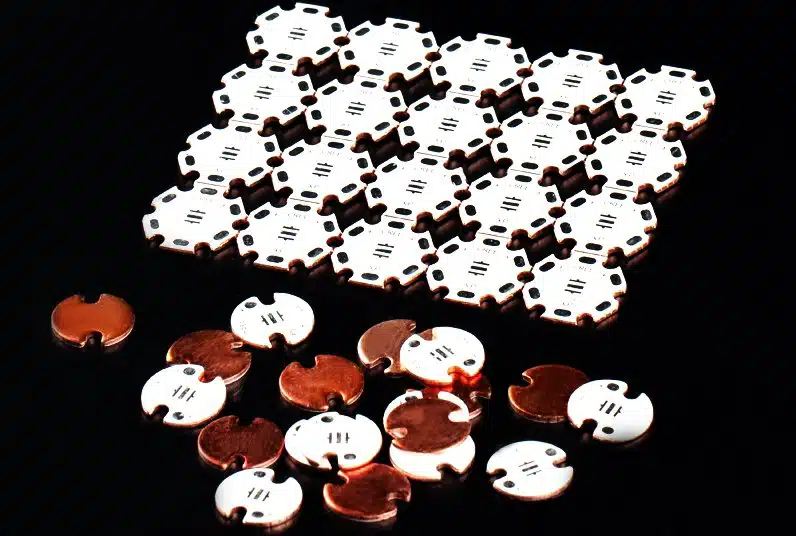When it comes to prototyping your PCB design, choosing the right material is crucial. The material you select will impact the performance, cost, and durability of your final product. With so many options available, it can be challenging to determine which material is best suited for your project.
In this article, we’ll provide a comprehensive guide to comparing different PCB materials for prototyping. We’ll discuss the advantages and disadvantages of some of the most commonly used materials, including FR-4, metal core PCBs, and Rogers PCBs.
By the end of this guide, you’ll have a better understanding of the different types of materials available and how to choose the right one for your specific needs. So, let’s dive in!
FR-4
FR-4 is a widely used material in the PCB industry and is made of a woven glass fabric core with an epoxy resin binder. It’s a cost-effective option that offers good electrical insulation properties and thermal stability.
Advantages:
- Cost-effective: FR-4 is one of the most affordable materials available for PCB prototyping, making it a popular choice for low-cost projects.
- Good electrical insulation properties: FR-4 has excellent electrical insulation properties, which make it suitable for high-frequency applications like RF circuits.
- Thermal stability: FR-4 has good thermal stability, which means it can withstand high temperatures without degrading or melting.
Disadvantages:
- Limited flexibility: FR-4 is a rigid material, which makes it less suitable for flexible PCB designs.
- Poor heat dissipation: FR-4 doesn’t dissipate heat as well as other materials, which can be a problem for high-power applications.
According to a report by MarketsandMarkets, the global FR-4 market size is projected to reach USD 2.3 billion by 2025, growing at a CAGR of 6.9% from 2020 to 2025.
While FR-4 is a cost-effective and widely used material, it may not be the best choice for all projects. Let’s take a look at another commonly used material for PCB prototyping – metal core PCBs.

Metal Core PCBs
Metal core PCBs, also known as MCPCBs, are PCBs with a metal core layer instead of the traditional FR-4 material. The metal core provides better thermal conductivity, making it suitable for high-power applications.
Advantages:
- Better heat dissipation: Metal core PCBs have excellent heat dissipation properties, making them ideal for high-power applications that generate a lot of heat.
- Improved durability: Metal core PCBs have better mechanical strength than FR-4, making them more durable and resistant to vibration and shock.
- High thermal conductivity: The metal core in MCPCBs provides better thermal conductivity than FR-4, which can help to improve the overall performance of the PCB.
Disadvantages:
- Higher cost: MCPCBs are generally more expensive than FR-4 PCBs due to the cost of the metal core layer.
- Limited flexibility: Like FR-4, MCPCBs are rigid and not suitable for flexible PCB designs.
According to a report by Grand View Research, the global MCPCB market size was valued at USD 1.35 billion in 2020 and is projected to grow at a CAGR of 6.2% from 2021 to 2028.
For high-power applications where heat dissipation is a concern, metal core PCBs are often the preferred choice. However, for projects where flexibility is important, another type of PCB material may be a better option – Rogers PCBs.

Rogers PCBs
Rogers PCBs are a type of high-performance PCB material that uses a ceramic-filled hydrocarbon resin system. They offer excellent electrical and thermal properties, making them ideal for high-frequency applications.
Advantages:
- High-frequency performance: Rogers PCBs have excellent electrical properties, including low dielectric loss and low signal loss, which make them suitable for high-frequency applications.
- Good thermal stability: Rogers PCBs have good thermal stability, which makes them suitable for use in high-temperature environments.
- Flexibility: Rogers PCBs can be made into flexible PCBs, making them suitable for applications where flexibility is important.
Disadvantages:
- Higher cost: Rogers PCBs are generally more expensive than FR-4 PCBs due to the materials used in their construction.
- Limited availability: Rogers PCBs are not as widely available as other types of PCB materials, which may make them harder to source.
According to a report by Transparency Market Research, the global Rogers PCB market size was valued at USD 1.28 billion in 2019 and is expected to grow at a CAGR of 8.5% from 2020 to 2027.
For high-frequency applications where electrical performance is critical, Rogers PCBs are often the preferred choice. However, they may not be the best option for projects with tight budget constraints.
Conclusion
Choosing the right material for your PCB prototype is essential to ensure optimal performance, durability, and cost-effectiveness. By understanding the advantages and disadvantages of different PCB materials, you can make an informed decision based on your specific project requirements.
Whether you choose FR-4 for its affordability and electrical insulation properties, metal core PCBs for their superior heat dissipation, or Rogers PCBs for their high-frequency performance, selecting the right material is key to the success of your project.












